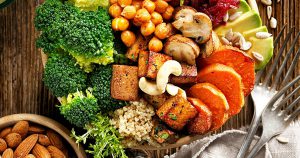
Proteins, along with carbohydrates and fats, are the three nutrients that provide calories or energy, in addition to performing other functions in the body. The main purpose of proteins is to build, repair, and maintain all body tissues which includes cartilage, blood, bones, muscles, and skin. They also support normal digestion and help fight infection. Since carbohydrate is our main source of energy, our bodies will only use energy from protein when carbohydrate and fat energy sources are not available.
Proteins are made from amino acids, known as the building blocks of life.
There are 20 different amino acids. Proteins are made of different combinations of amino acids depending on their function. There are two groups of amino acids: essential and nonessential. Essential means our body does not have the ability to make the amino acid in adequate amounts and therefore we must consume it in our diets. Nonessential means our body can make the amino acid. We also get nonessential amino acids from foods.
Two Groups of Amino Acids
Nine Essential Amino Acids:
These are not made by the body in sufficient quantities and must be consumed from food. They are histidine, isoleucine, leucine, lysine, methionine, phenylalanine, threonine, tryptophan, and valine.
Eleven Nonessential Amino Acids:
These are produced in sufficient quantities by the body. They are also found in certain foods. They are alanine, arginine, asparagine, aspartic acid, cysteine, glutamic acid, glycine, proline, serine, and tyrosine.
How can you make sure you are getting all the essential amino acids from food required to meet your protein needs for good health?
The best way is to consume a balanced diet every day featuring a variety of healthful foods. You don’t need to eat foods at each meal that contain all nine essential amino acids as long as your total daily consumption includes them in adequate amounts to meet your protein needs.
Which foods contain all the essential amino acids and which ones contain some essential amino acids?

Most foods contain the 20 amino acids; however, they are present in different amounts.
Foods that contain adequate amounts of all the essential amino acids come from animal products which include meat, poultry, fish, eggs, milk, yogurt, and cheese.
Foods lower in one or more essential amino acids come from plant foods which include fruits, vegetables, legumes, grains, nuts, and seeds.
Click here to visit UF/IFAS Extension for more information about protein in your diet.
 0
0
